A Protocol for Making Renewable Energy Sizing and Selection Decisions
Much has been written about renewable energy, but few stories have focused on the complexity of determining the optimal mix of solar and wind generation, and the kind and amount of energy storage, that implementation of renewable portfolio standards will require. This article describes a protocol to do that. The findings show that the amount of required storage will be several times greater than most people in the power industry believe, and that prevailing weather conditions are a critical component of the decision-making.
Climate change concerns have resulted in state governments issuing regulations that require increased use of renewable energy such as solar and wind power. At least 29 states and the District of Columbia have passed renewable portfolio standards (RPSs), and eight additional states have set non-binding renewable energy goals. These regulations vary considerably, with some RPS requirements applying only to investor-owned utilities, and some including municipalities and electric cooperatives. Fifteen states have requirements for 25% or greater renewable energy within the next 10 years, and seven states have requirements for 50% or greater with timeframes longer than 10 years. This situation, together with uncertainties surrounding lithium-ion (Li-ion) batteries and the availability of suitable alternative storage technologies makes investment decisions difficult for all stakeholders.
Currently, limited renewable energy is incorporated into the grid through the use of conventional energy operating strategies, which account for the generation limitations of solar and wind. However, as the requirements for renewable energy increase, adequate and reliable storage will become a critical necessity because solar and wind power are intermittent. A methodology to determine the necessary type and size of renewable energy generation and storage requirements to meet customer expectations of reliable electricity 24 hours a day under all weather conditions is needed. The insights that follow are the result of such a methodology.
A Renewable Energy Generation and Sizing Methodology
Solar power is only generated during daylight hours and is significantly affected each day and over the year by cloudy and partially cloudy days. Wind speed can also change drastically over the course of the day and with long-range weather patterns. Both solar and wind variability significantly affect the sizing of a specific renewable energy power facility. The charging and discharging efficiency and parasitic power loss associated with the storage component not only affect the size of the storage facility, but also that of the solar or wind farm.
The existence of these variabilities, which do not exist with conventional power sources, suggests that the analysis of renewable energy storage must be done over short periods to assure that renewable energy and associated storage are adequate to meet the grid load at all times, while meeting the regulatory requirements under all weather conditions. In this article, a proprietary model utilizes a methodology that considers factors such as grid load, RPS requirements, type of storage facility, charge/discharge efficiency, solar generation profile, typical cloud conditions, and wind speed profile, among other things. The insights that follow are based on typical equipment operating characteristics, weather conditions, and capital investment for the solar farms, wind farms, and various storage technologies.
The analysis for a specific site is unique because it must take into account the expected prevailing weather conditions at the location over the course of a year. Some of the characteristics that must be considered in making renewable energy investment decisions include the size and type of the installation, expected weather conditions, capital costs, operating costs, equipment reliability, and maturity of the technology. The development and demonstration status of storage technologies is a critical consideration in utility industry short- and long-term planning.
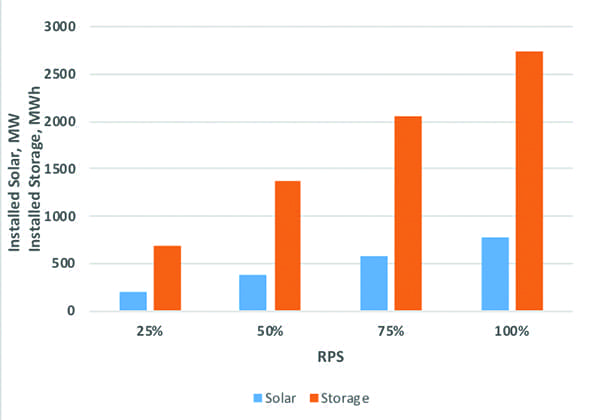 |
|
1. This chart shows the required solar and storage capacity needed under ideal weather conditions to accommodate four different renewable portfolio standard (RPS) scenarios for a grid with a maximum daily load of 200 MW. Source: The Ledgemont Group |
The analysis must be done in a manner that assures renewable energy and associated storage is adequate to meet grid load requirements at all times for various regulatory requirements and weather conditions. The results shown in Figure 1 are derived from such a proprietary model that analyzed solar and storage capacity required to supply power during a typical day for a grid that has a 200-MW maximum daily load with typical generation and storage equipment. The model can be adapted to the conditions at any proposed renewable energy installation. The results of the modeling will change for storage technologies that have different performance characteristics.
Figure 1 shows the increase in required solar energy generation and storage as the RPS increases from 25% to 100%, assuming a typical solar profile under ideal weather conditions with Li-ion battery storage technology deployed. Not only does the size of the required renewable solar generation increase, but also the necessary storage increases significantly. The size of both the required solar generation and storage will increase even more when weather conditions are taken into account, as will be shown.
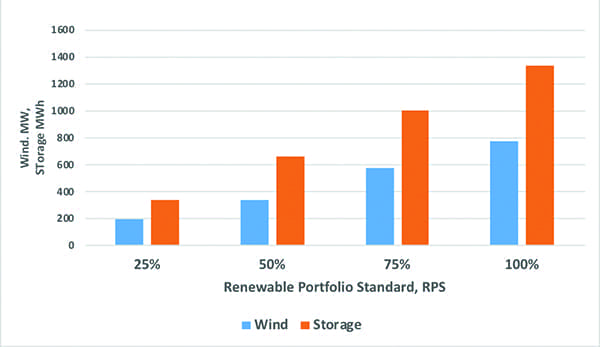 |
|
2. This chart shows the required wind and storage capacity needed to accommodate four different RPS scenarios when constant 25-mph winds are modeled for a grid with a maximum daily load of 200 MW. Source: The Ledgemont Group |
The equipment sizes of a typical wind generator with 25 mph wind and Li-ion battery storage necessary to achieve various RPSs are shown in Figure 2. Again, not only does the size of the renewable wind generation increase, but the necessary storage also increases significantly as the RPS ratchets up. Considering less-than-ideal wind conditions will also increase the required size of the wind generation and storage facilities.
The Impact of Weather
As requirements for the use of renewable energy such as solar and wind increase, the power industry will become increasingly dependent on the weather. Historically, utilities’ weather concerns were mainly limited to the grid’s ability to supply adequate power during summer heat waves and winter cold spells, and the effect winds have on power lines during snow/ice storms, hurricanes, and other weather-related events. Now, the industry will have to consider the impact of the frequency of cloudy and partially cloudy days, as well as long-term wind patterns and diminished wind events.
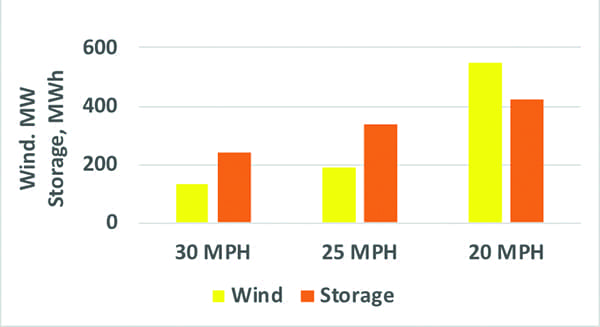 |
|
3. This chart shows the calculated wind and storage capacity required to accommodate a 25% RPS under three different maximum daily wind speed scenarios for a grid with a maximum daily load of 200 MW. Source: The Ledgemont Group |
Figure 3 shows the impact of wind speed on the necessary size for a wind farm with a Li-ion storage facility. The impact of generated wind power changing by the cube of wind speed is clearly seen in the 20-mph scenario. The impact of cloudiness on the necessary size of a solar farm and Li-ion storage facility is shown in Figure 4. It can be clearly seen that a renewable energy generation and storage facility will have to be sized taking into account the anticipated weather conditions over the course of a year. The power industry will be faced with studying and understanding historic and anticipated wind and cloudiness patterns at the location in which the facility will operate.
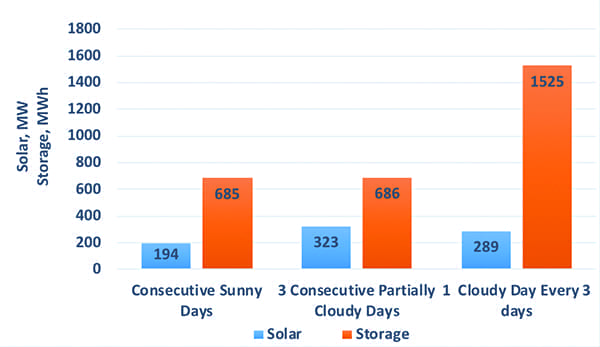 |
|
4. This chart shows the required solar and storage capacity needed to accommodate three different cloud cover scenarios under a 25% RPS for a grid with a maximum daily load of 200 MW. Source: The Ledgemont Group |
The Impact of Energy Storage Technologies
The power industry is not limited to current storage technologies because the incorporation of renewable energy generation and storage is a long-term game. Many RPSs increase over time, and there is considerable energy storage research and development currently in progress. Utilities are faced with determining which of these technologies has the greatest economic and reliability potential. Short-term decisions can be made considering currently proven storage technologies, but more economic and reliable technologies can be part of long-term plans. Of course, all storage technologies ultimately utilized must be demonstrated and proven reliable before utilities can fully trust them.
There are various types of storage technologies being considered for renewable energy storage installations including gravity (pumped hydro, and physical raising and lowering of blocks), batteries (Li-ion and flow batteries), chemical (electrolytic produced hydrogen), thermal (molten salt, regenerative stove, and phase change), and mechanical (compressed air energy storage and flywheel), among others. There are only three storage technologies currently thought to be proven and demonstrated as reliable for incorporation into an electric grid employing solar panels and wind turbines. Although there may be differences in criteria for proven and reliable, the three are Li-ion batteries, gravity pumped hydro, and flywheels.
However, each of these storage technologies has issues. For example, pumped-hydro storage requires land for reservoirs, which even if benign geology is available, often faces governmental and public approval challenges. Li-ion batteries face heat removal challenges in large facilities, and the economic impact of replacement and disposal costs as performance decreases over the life of facilities. Flywheels are quite costly, and additional hurdles exist for other technologies.
There are inherent technical risks the power industry must consider as it investigates the various storage technologies. As with sizing, this can be quite complex. Utility industry executives should ask storage technology developers whether the inherent technical and scale-up risks have been addressed and mitigated to the fullest extent possible and what the economic consequences could be, if expectations are not met. The power industry may not possess the in-house mechanical, chemical, thermal and hydrologic expertise to evaluate the wide range of storage technologies.
It is not possible to predict what storage technologies will ultimately be the economic and reliable technologies of the future. At this time, the developing technologies closest to commercialization appear to be vanadium flow batteries, and the physical lifting and lowering of blocks. Other battery technologies are at earlier stages of development.
The heating of molten salt directly with electricity has not been adequately demonstrated for use in conjunction with solar panel and wind generated electricity, even though molten salt has been used for collection and storage in parabolic solar tower plants. However, one such facility, a government-funded 110-MW molten salt plant at Crescent Dunes, Nevada, is no longer operational and has serious technical and financial problems.
Hydrogen and fuel cell systems could benefit from new water electrolysis technology. Compressed air energy storage is complex and costly. Little work is currently underway on regenerative stove technology, although it has been successfully demonstrated in the steel industry.
In the short term, storage options are limited. However, in the long term, there is still time for utilities to identify and support research and development into more economic and reliable storage solutions. Regulatory agencies must also consider the reliability and economic impact of the storage technologies they permit onto the grid.
A major consideration regarding storage is who pays for it: the utility adding the renewable energy, the transmission operator, or the customer (who could be required to have on-site storage technology at their home or business). Of course, the customer ultimately pays in all cases, but the details are a critical decision for regulatory agencies, so it is important to know how much storage is needed and its cost.
The Complexity of Renewable Energy Generation and Storage Decision-Making
The utility’s investment decision as to the type of renewable energy and storage technology to incorporate into the grid must consider both economics and reliability. Similarly, ISOs/RTOs and regulatory agencies must have assurance that the renewable energy and storage technologies that they approve provide the reliability society expects.
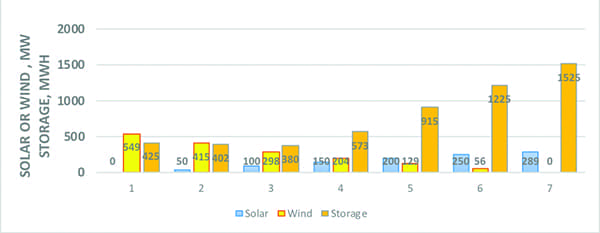 |
|
5. This chart shows seven different solar and wind power capacity mix scenarios from 0 MW solar to 0 MW wind designed to accommodate a 200-MW maximum daily load under a 25% RPS requirement with a lithium-ion battery storage system installed. Source: The Ledgemont Group |
An example of the complexity involved in determining the size of a renewable energy and storage facility is shown in Figure 5. Seven scenarios are shown, ranging from all solar to all wind with five solar-wind mixes in between. In each case, the sizes are calculated to meet a maximum daily load of 200 MW under a 25% RPS requirement in an area with 20-mph maximum wind speed, one cloudy day out of every three days, and utilizing a Li-ion battery storage system.
It can be seen that considerably greater storage is needed for the all-solar scenario than for the all-wind scenario. Of significance, it also shows that sizes are minimized whenever a mix of solar and wind is possible.
Financial analysis requires consideration of capital, operating, and maintenance costs, and expected life of the facility. In this example, the initial capital cost is calculated using $1 million/MW for solar, $1.75 million/MW for wind, and $175,000/MWh for Li-ion storage. However, this protocol is only the first step in making the most economic renewable energy decision. A more detailed analysis would be necessary incorporating specific equipment and location dynamics.
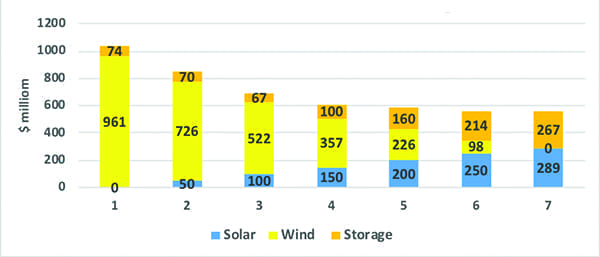 |
|
6. This chart shows a simplified economic analysis of seven different solar and wind power capacity mix scenarios from 0 MW solar to 0 MW wind designed to accommodate a 200-MW maximum daily load under a 25% RPS requirement with a lithium-ion battery storage system installed. Source: The Ledgemont Group |
Total capital investment for the seven scenarios is shown in Figure 6. Because of the higher capital investment cost of wind compared to solar, the analysis indicates that capital investment decreases with increased use of solar and is minimum for a mix of solar and wind. However, in many parts of the country the option for wind farm usage is limited by the absence of adequate sustained wind. Another factor to be considered in decision making is that the land necessary for solar is at least three times that for wind.
Storage operating characteristics can impact costs meaningfully. For example, if a storage technology with lower charging and discharging efficiency, and greater parasitic power loss, replaces the Li-ion batteries for the same conditions as Figure 5, a significant increase in the necessary size of both the generation and storage equipment is shown by the model to be required. Accordingly, the capital investments are significantly higher when a less efficient storage technology is employed.
Sound Models Are Vital to Success
Power companies must make renewable energy and energy storage decisions that they have not previously faced, and many may not have the internal resources to provide the necessary guidance. Questions that must be answered include:
- ■ What size solar, wind, or solar-wind mix is needed to meet applicable RPS requirements?
- ■ What size and type of storage technology is necessary in conjunction with the solar, wind, or solar-wind combination?
- ■ As energy storage systems evolve, what technologies are most economic and reliable in the short term and midterm, and what are likely to be available in the future?
Accurate information is necessary to make good decisions. The protocol used in this analysis shows that the size of required storage and the impact of weather are much greater than most power companies currently estimate. Time and money spent in the planning phase will benefit companies as they make choices for the future. ■
—Jagdish C. Agarwal, PhD and Richard A. Giberti, PhD are founding partners of The Ledgemont Group LLC.